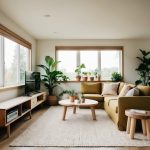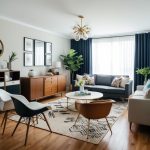Essential Home Decor Tips for Creating a Cozy and Inviting Living Room: Expert Advice for a Welcoming Space
Creating a cozy and inviting living room doesn’t require an interior design degree or an unlimited budget. Anyone can transform their space with a few thoughtful touches and strategic choices. Start by selecting a warm color palette that invites relaxation and comfort. Colors like soft earth tones, muted blues, and warm grays can create an atmosphere of tranquility and warmth.
Furniture arrangement is crucial to encourage social interaction and comfort. Place seating in a way that makes conversation easy, such as around a central coffee table or fireplace. Adding layers of texture through throws, cushions, and rugs can significantly increase the coziness factor. These elements introduce both visual and tactile warmth to the room.
Lighting plays a significant role in setting the mood of a living room. Incorporate a mix of lighting sources like floor lamps, table lamps, and dimmable overhead lights. The right lighting can instantly make a space feel more inviting and comfortable. Personal touches such as family photos, artwork, and cherished collectibles also enhance the room’s welcoming atmosphere, making it uniquely yours.
Understanding the Role of Color and Light
Creating a cozy and inviting living room requires thoughtful choices in both color and lighting. Balancing these elements can transform the space, enhancing its aesthetic and mood.
Choosing a Color Palette
The color palette sets the tone for the living room. Warm colors like earth tones and soft neutrals create a welcoming atmosphere. Blues and greens, being calming, can make the space feel more serene. Accent colors add vibrancy without overwhelming the senses.
Selecting paint finishes also impacts the room’s feel. Matte finishes absorb light and create a softer look, while glossy finishes reflect light, adding a sense of depth and brightness. Coordinating furniture and decorative items with the wall color creates cohesiveness and harmony.
Maximizing Natural Light
Natural light makes a significant difference in any living room. Using light, airy curtains or blinds, one can control the amount of sunlight entering the space. Mirrors enhance natural light by reflecting it throughout the room, making it appear larger and brighter.
Positioning furniture to avoid blocking windows ensures an unobstructed flow of light. Light-colored walls and flooring amplify the effect of natural light. Using skylights or large windows, where possible, greatly enhances the room’s illumination, creating a warm and inviting atmosphere.
Layering Artificial Lighting
Artificial lighting plays a crucial role when natural light is lacking. Combining ambient, task, and accent lighting layers different light sources, offering functionality and ambiance. Ceiling lights or chandeliers provide overall illumination, while floor and table lamps add focused lighting for reading or other activities.
Accent lights highlight architectural details, art, or decor, adding depth and character. Dimmer switches enable control over the lighting intensity, allowing for adjustments based on the time of day or activity. Thoughtful placement of artificial lighting ensures a balanced, inviting living room atmosphere at any time.
Furniture Selection and Arrangement
Choosing the right furniture and arranging it properly can transform a living room into a welcoming and comfortable space. Find comfortable seating options and create a layout that allows for easy movement.
Choosing Comfortable Seating
Comfortable seating is essential for a cozy living room. Consider a sofa that offers both style and comfort, ensuring it’s the right size for the space. Include armchairs or recliners to provide additional seating options.
Selecting upholstery that is soft and durable can enhance the overall comfort and longevity of the furniture. Material such as microfiber or leather can be both stylish and resilient. Don’t forget to add cushions and throws that complement the color scheme and add extra coziness.
Arranging seating around focal points such as a fireplace or TV can make the room more inviting. Ensure there is plenty of space for guests to sit comfortably without feeling cramped.



